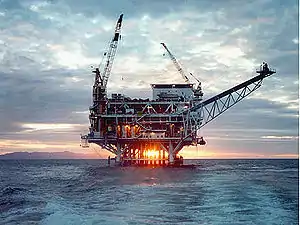Chemical industry in the United Kingdom
The chemical industry in the United Kingdom is one of the UK's main manufacturing industries. At one time, the UK's chemical industry was a world leader. The industry has also been environmentally damaging, and includes radioactive nuclear industries.
History

Sir William Henry Perkin FRS discovered the first synthetic dye mauveine in 1856, produced from aniline, having tried to synthesise quinine at his home on Cable Street in east London. Perkin's work, alone, led the way to the British chemical industry.
21% of the UK's chemical industry is in North West England, notably around Runcorn and Widnes. The chemical industry is 6.8% of UK manufacturing; around 85% of the UK chemical industry is in England.
Output
In 2015, the UK chemical industry exported £50bn of products.[1] The industry employs about 30,000 in research and development.
Regulation
Regulation of the UK chemical industry is largely under the European Chemicals Agency (ECHA) and the Registration, Evaluation, Authorisation and Restriction of Chemicals legislation (REACH).
Chemical plants
Teesside and Cheshire are areas with an established chemical industry. Significant chemical plants in the UK include:
- Billingham Manufacturing Plant, former ICI plant that makes nitrate fertiliser[2]
Companies
Significant chemical companies in the UK have been:
- Fisons, a significant East of England fertiliser company, bought in 1995
Organisations
Relevant organisations related to the UK chemical industry are the Institution of Chemical Engineers (IChemE), the Chemical Industries Association, and the Society of Chemical Industry. The chemical industry in Europe is represented by the European Chemical Industry Council or CEFIC.
